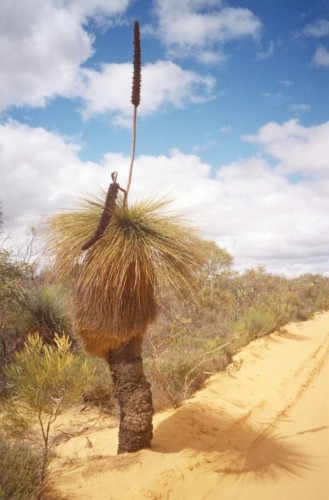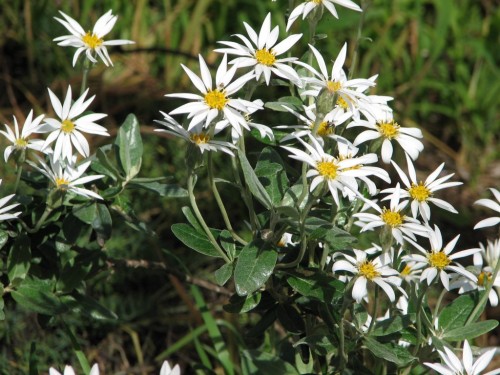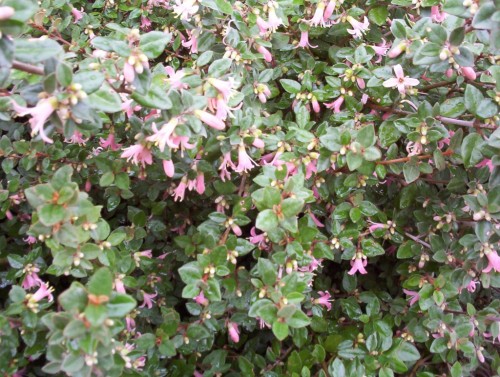Xanthorrhoea Photo
A friend, Jeff, emailed this photo to me wondering about the botanical name (which he found for himself before I had read his email.) He said the photo was taken at Kalbarri in WA so I thought it probably was specifically Xanthorrhoea priessii when I looked up a reference. Then I realised that I had called the trunkless species by this name in a previous post.
Investigating this I realised that the trunkless species is Xanthorrhoea gracilis which grows around Perth, Western Australia. It seems that they are all probably frost hardy.
The trunk on a Xanthorrhoea is called a caudex.
I will show the reason for Jeff’s enquiry later!
Brachyscome angustifolia hybrid
Here is an example of a photograph of one of the Brachyscome species that I grow. Typically the colour has not been reproduced correctly. This hybrid daisy has flowers that are nearly a cerise pink.
It seems to be a hardy plant which suckers readily. It tends to die back during the heat of summer, to reappear as the cooler weather arrives and watering is resumed or rain falls. It flowers for a couple of months. I am not sure of its frost tolerance as the plants are in a fairly sheltered spot to protect them from the high temperatures during the summer.
The daisy garden bed which I began a few years ago needs to be re-organised as it was n
meant to be a show case and a test garden for the pH of the soil and heat and frost tolerance.
Photographing Daisies
It is so difficult to take photos of plants that are in the mauve / blue / purple colour range. I have tried photography in the shade, at night with a flash, relying on the editing facility with digital photography and still been disappointed with the results.
There are a number of members of the daisy family, in particular Olearia and Brachyscome which have these colours. A mass of mauve Brachyscome multifida will look a dirty white or ‘washed out’ pink. One day I will come across some clues to help with this. Meanwhile when I try to tell anyone about the beautiful colour of the purple form of Olearia floribunda, I feel great frustration that I cannot show them what I mean. Similarly with Olearia ciliata which varies in colour from mauve to purple.
All these have the typical daisy shaped flower which vary in size from 1cm to 5cm across. Some look good as cut flowers in small posies. All look great as potted plants and garden plants.
I enjoy propagating these plants from seed and cuttings. Cuttings strike fairly easily in warmer weather.
Olearia pannosa
This daisy was the reason I joined the Australian Daisy Study Group. This is one of many study groups set up under the auspices of the Australian Societies for Growing Australian Plants (ASGAP). Most daisies I had seen were relatively insignificant but the large flowers on this plant were stunning. The bush covers itself in 70mm wide white fllowers.
I enjoy and appreciate the information that is available through membership of the study group.
I noticed that the plants are beginning the spurt of growth that comes just before the flower buds form. It flowers at the end of winter.
It is one of those plants that needs to be cut back after flowering. It has the appearance of a shrub but behaves like a perennial plant. New growth appears lower down the stems. I am never sure whether to cut back to the bottom most part of this. Members of the study group have not had a great deal of success when cutting back into older wood on some of these daisies. I have never cut back too severely.
This is one that grows quite well in the highly alkaline soil that is in my garden. Not as vigorous as the plants that grow where the rainfall is a little higher and there is not so much limestone.
Correa ‘Candy Pink’ syn. Correa ‘Pink Pixie’
I thought I would gradually add photos of the plants that I have written about in previous blog entries.
One of many favourite plants is Correa ‘Pink Pixie’. Can I use that expression ‘many favourite’? Anyway, this is a delightful flowering plant with the flower tube split and looking like a little flared skirt as I would imagine a pixie would wear. Hence the name. Unfortunately for that Correa, its correct name is Correa ‘Candy Pink’ and it may also be the plant that is called Correa ‘Mallee Pink’. It appears that the first name by which it was called ie C ‘Candy Pink’ is the one it should be known by. Pity really. ‘Pink Pixie’ suits the shape of the flower and ‘Candy Pink’ suits the colour of the flower.



